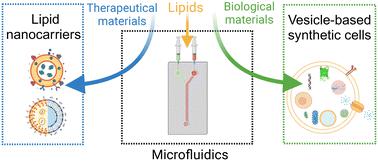Our official English website, www.x-mol.net, welcomes your
feedback! (Note: you will need to create a separate account there.)
Microfluidic technologies for lipid vesicle generation
Lab on a Chip ( IF 6.1 ) Pub Date : 2024-09-04 , DOI: 10.1039/d4lc00380b Yu Cheng , Callum D. Hay , Suchaya Mahuttanatan , Oscar Ces , James Wilkinson Hindley , Yuval Elani
Lab on a Chip ( IF 6.1 ) Pub Date : 2024-09-04 , DOI: 10.1039/d4lc00380b Yu Cheng , Callum D. Hay , Suchaya Mahuttanatan , Oscar Ces , James Wilkinson Hindley , Yuval Elani

|
Encapsulating biological and non-biological materials in lipid vesicles presents significant potential in both industrial and academic settings. When smaller than 100 nm, lipid vesicles and lipid nanoparticles are ideal vehicles for drug delivery, facilitating the delivery of payloads, improving pharmacokinetics, and reducing the off-target effects of therapeutics. When larger than 1 μm, vesicles are useful as model membranes for biophysical studies, as synthetic cell chassis, as bio-inspired supramolecular devices, and as the basis of protocells to explore the origin of life. As applications of lipid vesicles gain prominence in the fields of nanomedicine, biotechnology, and synthetic biology, there is a demand for advanced technologies for their controlled construction, with microfluidic methods at the forefront of these developments. Compared to conventional bulk methods, emerging microfluidic methods offer advantages such as precise size control, increased production throughput, high encapsulation efficiency, user-defined membrane properties (i.e., lipid composition, vesicular architecture, compartmentalisation, membrane asymmetry, etc.), and potential integration with lab-on-chip manipulation and analysis modules. We provide a review of microfluidic lipid vesicle generation technologies, focusing on recent advances and state-of-the-art techniques. Principal technologies are described, and key research milestones are highlighted. The advantages and limitations of each approach are evaluated, and challenges and opportunities for microfluidic engineering of lipid vesicles to underpin a new generation of therapeutics, vaccines, sensors, and bio-inspired technologies are presented.
中文翻译:

用于脂质囊泡生成的微流体技术
将生物和非生物材料封装在脂质囊泡中,在工业和学术环境中都具有巨大的潜力。当小于 100 nm 时,脂质囊泡和脂质纳米颗粒是药物递送的理想载体,可促进有效载荷的递送,改善药代动力学,并减少治疗的脱靶效应。当大于 1 μm 时,囊泡可用作生物物理研究的模型膜、合成细胞底盘、生物启发的超分子装置以及探索生命起源的原始细胞的基础。随着脂质囊泡在纳米医学、生物技术和合成生物学领域的应用越来越突出,对其受控构建的需求越来越大,而微流体方法处于这些发展的最前沿。与传统的批量方法相比,新兴的微流体方法具有诸如精确的尺寸控制、更高的生产通量、高包埋效率、用户定义的膜特性(即脂质组成、囊泡结构、区室化、膜不对称性等)等优势,以及与芯片实验室操作和分析模块的潜在集成。我们提供了微流体脂质囊泡生成技术的综述,重点介绍了最近的进展和最先进的技术。描述了主要技术,并强调了关键的研究里程碑。评估了每种方法的优点和局限性,并提出了脂质囊泡微流控工程以支持新一代疗法、疫苗、传感器和生物启发技术的挑战和机遇。
更新日期:2024-09-04
中文翻译:

用于脂质囊泡生成的微流体技术
将生物和非生物材料封装在脂质囊泡中,在工业和学术环境中都具有巨大的潜力。当小于 100 nm 时,脂质囊泡和脂质纳米颗粒是药物递送的理想载体,可促进有效载荷的递送,改善药代动力学,并减少治疗的脱靶效应。当大于 1 μm 时,囊泡可用作生物物理研究的模型膜、合成细胞底盘、生物启发的超分子装置以及探索生命起源的原始细胞的基础。随着脂质囊泡在纳米医学、生物技术和合成生物学领域的应用越来越突出,对其受控构建的需求越来越大,而微流体方法处于这些发展的最前沿。与传统的批量方法相比,新兴的微流体方法具有诸如精确的尺寸控制、更高的生产通量、高包埋效率、用户定义的膜特性(即脂质组成、囊泡结构、区室化、膜不对称性等)等优势,以及与芯片实验室操作和分析模块的潜在集成。我们提供了微流体脂质囊泡生成技术的综述,重点介绍了最近的进展和最先进的技术。描述了主要技术,并强调了关键的研究里程碑。评估了每种方法的优点和局限性,并提出了脂质囊泡微流控工程以支持新一代疗法、疫苗、传感器和生物启发技术的挑战和机遇。


















































 京公网安备 11010802027423号
京公网安备 11010802027423号